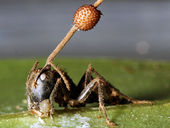
A fungus that attacks living ants apparently manipulates their behavior for its own benefit, an international research team reports in the September American Naturalist.
When the Ophiocordyceps unilateralis fungus strikes, an infected ant climbs to a leaf not far off the ground (often on the north-northwest side of a tree), bites in and dies with jaws locked in place. Experiments now show that these low-hanging leaves give the fungus prime conditions for growing a spore-bearing spike out of the ant's neck, says study coauthor David Hughes of Harvard University.
"Demonstrating that a change in host behavior benefits parasite fitness is not easy and is rarely done," says Shelley Adamo of Dalhousie University in Halifax, Canada, who also has studied manipulative parasites. And she welcomes this paper because it does show that the fungus benefits from its host's weird death.
"For me, it is a convincing evidence of manipulation," says parasitism researcher Frédéric Thomas of the Institut de Recherche pour le Développement in Montpellier, France.
As far back as the 1920s, biologists had proposed that Ophiocordyceps infections turned ants into tree biters that latched on to leaves, twigs or the bark depending on which fungal species attacked. The possibility of fungal influence on the sick ant "was just crying out to be looked at," Hughes says.
Hughes and colleagues from Denmark and Thailand studied O. unilateralis's effects on ants in a Thai forest. They found natural graveyards of dead ants, belonging to the species thought to be the fungus's main host, clamped onto leaves not far above the ground, typically just some 25 centimeters up. This first meter above the forest floor has more fungus-friendly humidity than the zones of the tree five meters and higher, the researchers report.
Selecting dead ants at an early stage of infection, the researchers moved some of the carcasses onto the forest floor and moved others high into the canopy. The fungus in ants that were relocated to the leaf litter didn't fare well, soon disappearing. Some foragers presumably ate them, or rain just swept them away. The high canopy didn't suit the fungus either. Dissections of ant corpses that were moved up there revealed deformed fungal growth that didn't produce spores.
Leaves near the tree base proved just right, though. A fibrous fungal spike grew out of the necks of ants there and bore a segmented, red-orange lump that Hughes compares to a lopsided pineapple.
Forming that lumpy body allows the fungus to reproduce - a clear benefit, Adamo says. But she adds, "The much harder question is whether the fungus is 'manipulating' its host." The suggestion seems reasonable in this case, she says, but notes that a colony-dweller might leave the nest when dying from a potentially contagious infection without necessarily falling under the direct control of the parasite. "I might have added a further test to the paper to see whether ants injected with heat-killed fungi, combined with a slow acting pesticide, would show the same behavior," she says.
"One thing I really like about this study is that it is largely field-based," says tropical arthropod ecologist Steve Yanoviak of the University of Arkansas at Little Rock. "It is easy," he says, "for someone, even a tropical field biologist, sitting in an armchair to forget that data collection in a study like this likely involved long hours in hot, humid conditions, constantly fighting the urge to itch yesterday's bites while under attack from yet more bloodsuckers."



Sounds like our friendly psychopaths doesn't it?